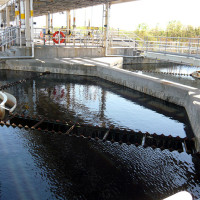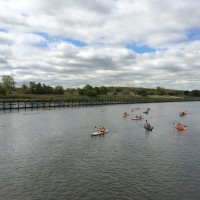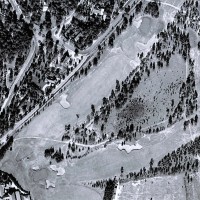Tags: infrastructure
Virtual Tour: Leachate Treatment Plant

Join Mr. Ted Nabavi, Director of Waste Management Engineering at DSNY, for a behind-the-scenes tour of the Fresh Kills Landfill Leachate Treatment Plant. Leachate, a landfill by-product, is created when water seeps through solid waste. Leachate treatment includes biological and chemical treatment to remove harmful constituents so the treated water can be safely discharged.
...MOREFreshkills Park, Fifteen Years after Landfill Closure

Fifteen years ago this week, the final barge of household garbage arrived at Fresh Kills Landfill. To celebrate this milestone, the website’s new interactive landfill-to-park timeline illustrates almost 100 years of changes in the area.
The last barge to Fresh Kills marked the end of 53 years of landfill operations.
...MOREUrban Omnibus: “Ted Nabavi Turns Hazards into Riches”

“I always wanted to get into environmental science to clean up hazardous waste,” Ted Nabavi said in his recent interview with Urban Omnibus. Ted has been working with DSNY for over 25 years, currently as the Director of Waste Management Engineering for the Bureau of Solid Waste Management.
...MOREFreshkills Park Helps You Keep New Year’s Resolutions

It’s easy to make resolutions at the start of the new year, but many of us struggle with keeping them for more than a few months. Fortunately, Freshkills Park will be there to help you accomplish a wide variety of goals in 2016.
...MOREThe Twelve Days of Freshkills Park

12 years since James Corner Field Operations won the City of New York design competition. In 2006, NYC Parks assumed responsibility for implementing the project using Field Operations’ Draft Master Plan as a conceptual guide. The basic framework of the plan integrates three separate systems—programming, wildlife, and circulation—into one cohesive and dynamic unit.
...MOREFarther Afield: NYC Curbside Gardens

Well known to city dwellers, the urban landscape is dominated by impervious hard surfaces that require manmade sewage infrastructure to handle all rainfall and storm water management. In normally functioning environments, soil and vegetation absorbs this water and retains it to a certain capacity before runoff is generated.
...MOREFarther Afield: Returning Pinehurst Golf Course to Nature

Nestled amongst the sand hills of North Carolina’s Piedmont region, the Pinehurst Resort’s Golf Course has done much to reduce its impact on local water infrastructure. Prior to the restoration, there were 2,100 sprinklers onsite and after the process is completed only 1,400 will remain – a reduction of more than 30% that will lead to a decline of the golf course’s consumptive water use by nearly 40 million gallons per year.
...MOREComposting Toilets in New York City
Prospect Park is building a composting toilet and putting to use an obsolete building. The Pump House, an unused building tucked away in the center of the park, is not connected to the New York City sewer system so traditional restrooms are not possible but with park use on the rise more restroom facilities are needed, especially in this more remote area of the park.
...MOREDallas’ newest park to be perched atop a highway

After the success of The Highline in New York, it seems that every city is now attempting to transform abandoned or underused public spaces into lush urban parks. Treehugger has reported on the recent developments in unusually located parks, the latest being the Klyde Warren Park in Dallas, Texas.
...MOREWhat if the Olympics had come to Staten Island?
If you, like us, are currently immersed in the London 2012 Summer Olympics, it is fascinating to imagine if the games were instead taking place in our own backyard… More specifically at Freshkills Park!
As WNYC has reminded us, during New York City’s bid for the Olympics back in 2005, Staten Island and Freshkills Park were featured as a prominent site for large scale sporting events.
...MOREReservoir conversions protect water supply, create parks
The City of Seattle is implementing an innovative program to protect their reservoir water supply and create 76 acres of new open space. Seattle Public Utilities (SPU) has already replaced five open reservoirs with underground structures – a system that both improves water quality and provides better security for the water supply – and an additional project is in the works.
...MORE2012 LAGI design competition July 1st deadline approaching
‘Renewable energy can be beautiful.’ That is the tagline for the 2012 Land Art Generator Initiative (LAGI) international design competition. The open LAGI competition calls for ideas to “design a site-specific public artwork that also functions as clean energy infrastructure for New York City.”
...MORECity outlines strategy to protect and create wetlands
Mayor Bloomberg and several City of New York agencies recently released The Wetland Strategy report, which outlines plans to protect and improve city waterways. The report contains strategies to address goals in PlaNYC 2030. Among the 12 initiatives are plans to:
- invest $48 million in projects that restore and enhance nearly 127 acres of wetlands and neighboring areas,
- add 75 acres of wetland to the New York City Parks system,
- create the natural areas conservancy to encourage a public-private partnership for wetlands management,
- create a wetlands mitigation banking or in-lieu fee mechanism for public projects.
How building subways helps build our parks
As work on Manhattan’s Second Avenue subway line progresses, those viewing the massively scaled operation may wonder, “where does all the excavated dirt and rock go?” In the past, the ‘muck’ from expanding subway lines and other construction projects has contributed to the building of Ellis Island, Governors Island and Battery Park City, among other city landmarks – including the expansion of the Manhattan shoreline.
...MOREBioswales and green infrastructure for New York
The future of green infrastructure within the New York metropolitan region just got brighter: NY State and City officials announced this week that over $2 billion in public and private investments would be committed to ecologically-sound techniques for the management of stormwater runoff and sewage overflow.
...MORELAGI Field Guide to Renewable Energy Techonologies
The Land Art Generator Initiative (LAGI) team recently announced the release of their Field Guide to Renewable Energy Technologies, a free resource they hope will prove useful to “all designers, homeowners, urban planners, students, artists, architects, landscape architects, engineers, and anyone else interested in a clean energy future”.
Small landfill, big ideas
Focus Forward, a new series of short films about forward-thinking innovators, brings us The Landfill, directed by Jessica Edwards and Gary Hustwit.
The film is a brief profile of the small but highly efficient Delaware County Landfill in Upstate New York, which is using a system of composting, recycling, and landfill gas (LFG) capture not unlike the one used at Fresh Kills two decades ago.
...MORETour Freshkills Park with an expert this Sunday
Over the course of the various stages of its history, a wide range of professionals have spent time working on or thinking about the Freshkills Park site: sanitation workers, engineers, equipment manufacturers, scientists, policymakers, architects, designers, artists, philanthropists. There are countless layers of expertise to mine in understanding the site.
...MOREStaten Island west shore planning study released
In June, the NYC Department of City Planning and the NYC Economic Development Corporation released Working West Shore 2030, a land use and transportation planning report that provides recommendations for decision-making along the west shore of Staten Island to developers, property owners, civic stakeholders and elected officials.
...MORENew sewage overflow protections for Jamaica Bay
The NYC Department of Environmental Protection has announced a $400 million upgrade to the 26th Ward Water Pollution Control Plant (WPCP) in Brooklyn that will reduce the amount of untreated sewage overflow entering Jamaica Bay during storm events by 1.2 billion gallons a year.
...MORE



